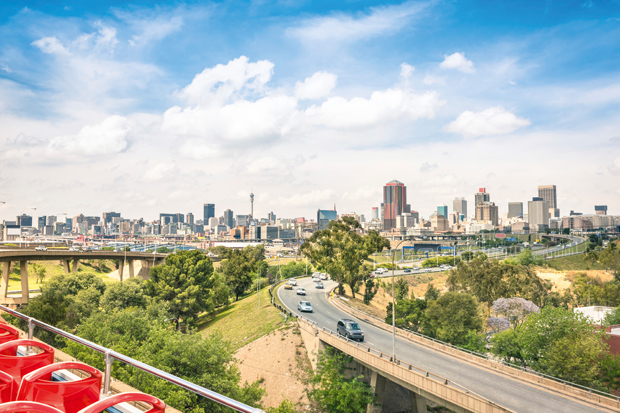‘You’ve got a lot to live up to,’ said the ranger. ‘The last Spectator journalist who stayed here was Jeremy Clarke. He made quite the impression.’ Like some sort of Zulu legend, our ‘Low life’ columnist’s time at Shambala game reserve is now talked about around the campfire — or braai as it is known in South Africa. ‘I heard he commandeered a safari vehicle and set off to find a drinking hole,’ said one of the camp staff. ‘He held a wet T-shirt competition,’ said another. ‘All the local women were very impressed.’ Apparently even Douw Steyn, who owns the reserve, still reminisces about Jeremy’s time there.
You might not have heard of Steyn, but you will know his work. He’s the insurance tycoon behind Compare the Market/Meerkat, and yet his carefully curated game reserve in Limpopo doesn’t feature a single meerkat. A lost opportunity, I’d say. Still, the animals that call Shambala home all look glossy and content. There wasn’t a mangy wildebeest in sight. The elephants we rode have a team of men who care for them and teach them to play football. Two male lions lolloped around, yawning like old playboys.
Shambala also sheltered Nelson Mandela. During his final years, Mandela would come to hang out on the beautiful reserve, picking up a KFC bucket from the nearby town of Vaalwater on his way in. Steyn also allowed his palatial pad in Johannesburg to be used as an open house during the ANC’s negotiations with P.W. Botha’s government, and Mandela polished off A Long Walk to Freedom there.
This Jo’burg residence is now the Saxon hotel and it’s a lovely base from which to visit the city. The fortress-like structure sits amid tall trees and cool pools in the leafy suburb of Sandhurst. It’s a heavily fortified area of town, with every building wrapped in reams of electrified wiring. The architecture speaks volumes about Jo’burg’s dangerous reputation. No wonder its wealthy residents are a paranoid bunch. I visited the city seven years ago and remembered the acres of slums next to the runway as the plane touched down. This time, peering out the window, I couldn’t see them. They had been razed at the time of the World Cup, in an attempt to clean up Jo’burg’s image. No one seemed to know where the people had been moved to.
Johannesburg is in flux, and much like New York, it has been shaped by waves of immigration. Every-thing is overshadowed by the history of apartheid, of course, but the city is trying hard to revamp its image. There are signs that this plan is working. An enthusiastic man named Gerald runs a company offering urban walking tours. A decade ago, he would never have been able to take us round on foot. But recently, parts such as the old mining district and Newtown have been renovated; they are safe to walk round. Jo’burg’s younger citizens have been offered affordable apartments in the centre of town, and as a result, the city has acquired a youthful vigour. A number of fashion designers have set up shop, the craft beer industry is thriving and on Fox Street, an old warehouse has been converted into a food market called The Sheds. I’m told the Soho House people have been sniffing round the Rand Club. A whiff of gentrification is in the air.
Still, parts of the city are grim. Hillbrow, home to a famous space-age tower, is a desolate place and we could only visit it by car. Its residents are primarily immigrants from neighbouring African countries and they are at the mercy of the pimps and drug lords. The lampposts were plastered with bright pink posters for ‘Dr Joy’s abortion clinic’. Later, we passed by the market where witchdoctors sell potions, carry out procedures and place curses. Somewhere in there was Dr Joy.
You take the good with the bad, I suppose. I bet Jo’burg feels a lot like New York did during the 1970s, and we all know how that turned out. The older generations, black and white, seem too caught up in post-apartheid angst to care about rejuvenating this mining city, so the job has gone to the young. It is by no means a beautiful place, but it is a fascinating one.
Back in London, I messaged Jeremy to check the stories. ‘Lara, how could I forget! We had the best time,’ he replied. ‘The wet T-shirt competition was like a row of chapel hat pegs. It was Saturday night and everybody was throwing back Captain Morgan rum and coke. At about three in the morning they said, “We’re all going on to a party now and you must come.” “Fantastic!” we said. “How far away is it?” “About 300k.” Only lack of diesel prevented it.’ In deepest Limpopo, the legend lives on.
For more about Shambala game reserve and Saxon Hotel, see www.saxon.co.za. The Zulu Camp & Saxon Hotel, Villas and Spa Accommodation Package consists of the following: 2 Nights at Saxon Hotel, Villas and Spa (B&B basis); 3 Nights at Zulu Camp (inc one morning and one evening game drive per day); Transfers to and from Saxon Hotel to Zulu Camp; Couples Spa Journey at the Saxon Hotel; All other inclusive value adds as part of a normal Zulu Camp stay.
2015 High Season, November to April – R43 000.00
2015 Low Season, May to October – R34 945.00
Gerald Garner’s Jo’burg Places Walking Tours can be found at www.joburgplaces.com
Got something to add? Join the discussion and comment below.
Get 10 issues for just $10
Subscribe to The Spectator Australia today for the next 10 magazine issues, plus full online access, for just $10.
You might disagree with half of it, but you’ll enjoy reading all of it. Try your first month for free, then just $2 a week for the remainder of your first year.















Comments
Don't miss out
Join the conversation with other Spectator Australia readers. Subscribe to leave a comment.
SUBSCRIBEAlready a subscriber? Log in